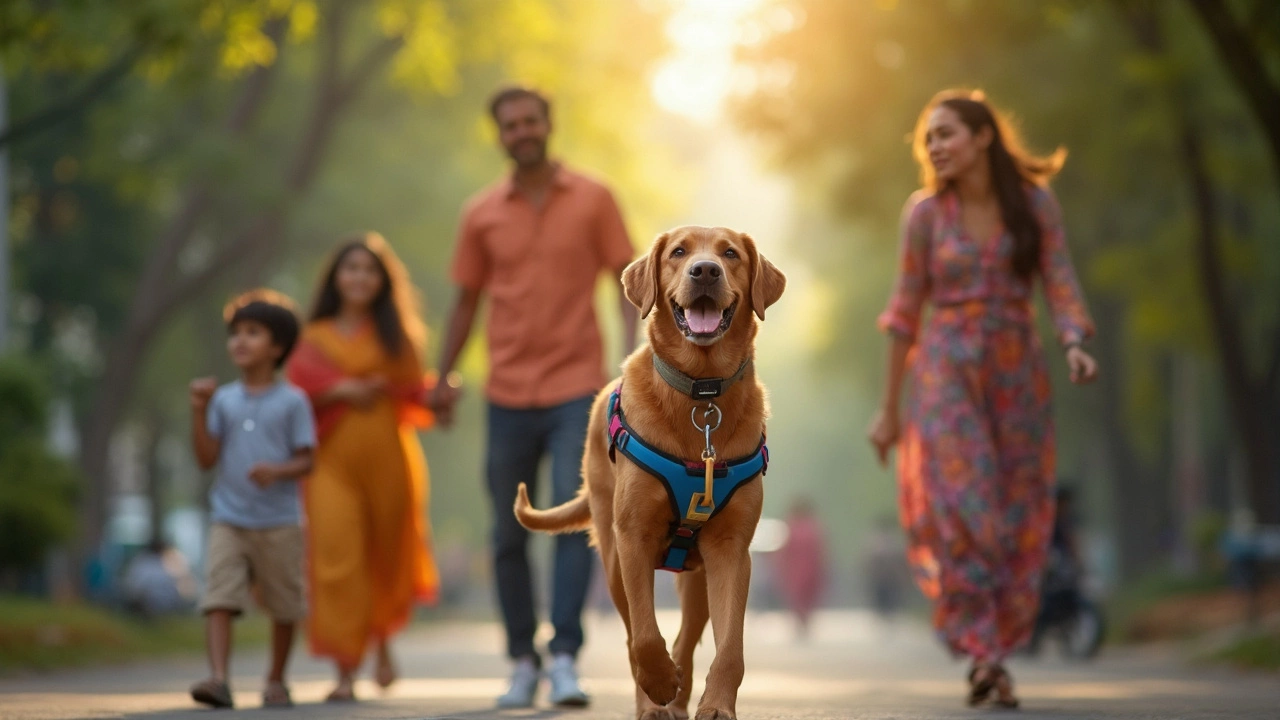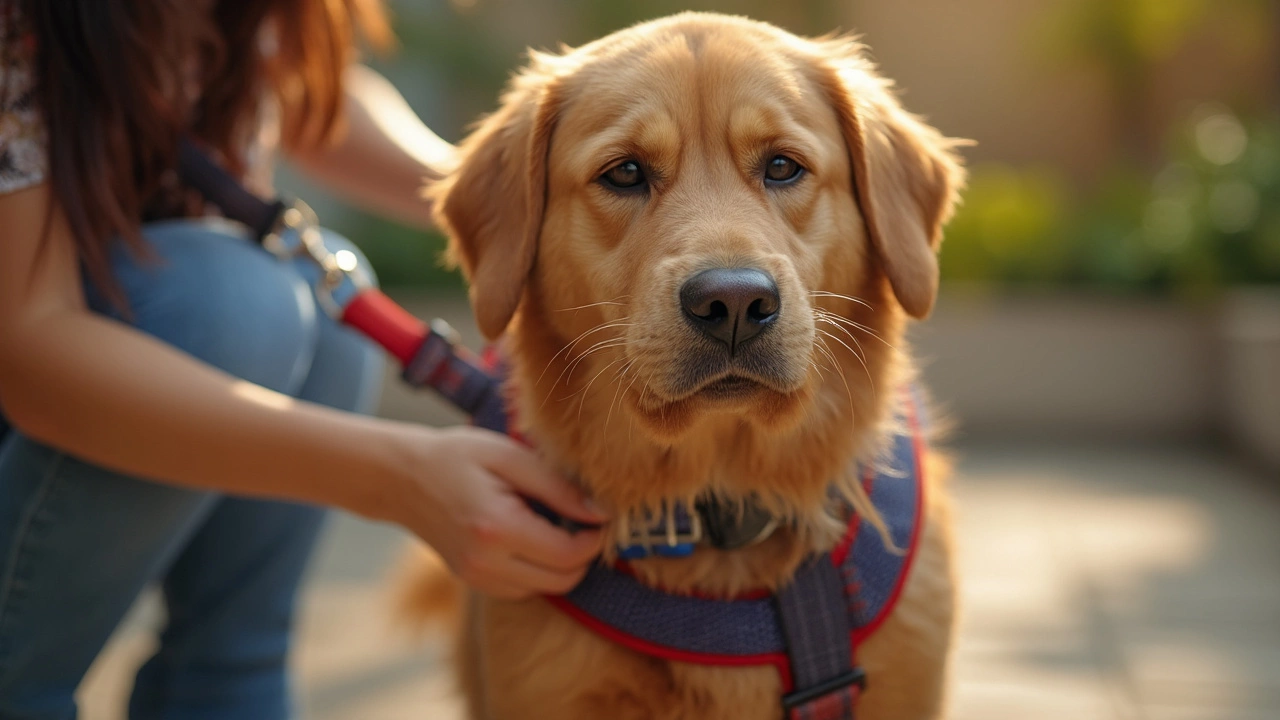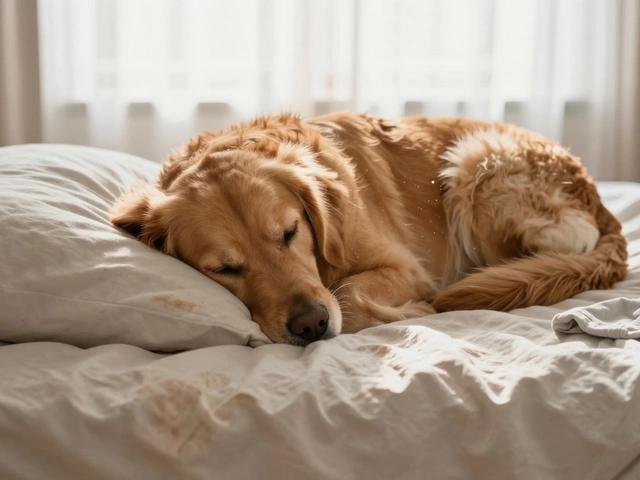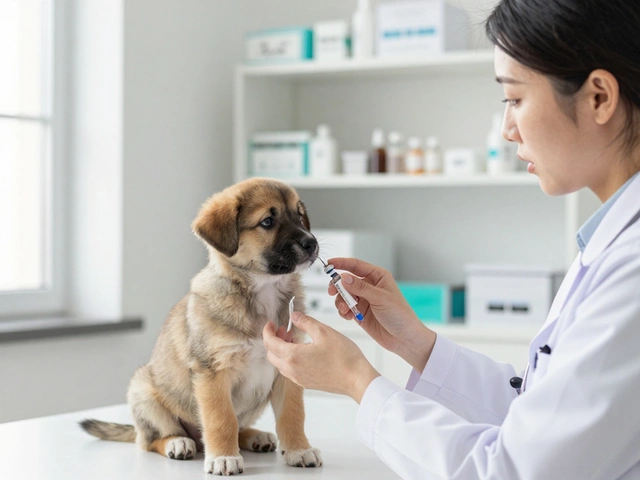
Combining a collar and a harness sounds like overkill, right? Actually, it's pretty common. Walk through any city park and you'll spot plenty of dogs decked out with both. But just because other people are doing it, should you?
First up, it’s totally possible—and often practical—to put both a collar and a harness on your dog. The big thing is knowing why you’d want to. Harnesses are designed to protect your dog's neck and give you better control (especially if your buddy pulls hard on walks). Collars, on the other hand, are great for holding ID tags and quick leash clips when you’re out and about or just letting your pup wander around at home.
Pairing them correctly isn’t just about looks or convenience. There’s actually a right and a wrong way to do this so your dog stays safe, comfortable, and easy to handle. Ready to figure out when doubling up makes sense and how to avoid common mistakes? Let’s break it down step by step.
- Why Use a Collar and a Harness Together?
- When Is It Safe or Unsafe?
- Getting the Right Fit for Both
- Potential Issues and How to Avoid Them
- Tips for Training and Daily Use
- Choosing the Best Gear for Your Dog
Why Use a Collar and a Harness Together?
You might be wondering if putting both a dog collar and a dog harness on your pup makes sense. Turns out, it’s not just a trend—there are solid reasons people double up when it comes to walking gear.
First, the collar is the go-to for holding ID tags and registration info. If your dog slips away (hey, it happens to the best of us), a collar with readable tags is usually the fastest way for someone to get your details. Plus, it’s always there, even when the harness comes off indoors or at the dog park. The collar is kind of like your dog’s wallet—just smaller and less likely to get lost on the couch.
But the harness brings a different kind of safety, especially out on walks. When you clip your leash to the harness, you take pressure off your dog’s neck. That’s huge if your dog likes to pull, lunges at squirrels, or just gets easily excited. Using a harness lowers the risk of trachea injury, which can actually happen with collars. Some vets say that small breed dogs, like pugs or Yorkies, are especially at risk for neck issues if you only use a collar for walks.
Check this out: In a quick survey done at a Chicago dog park in 2023, 62% of owners said they pair a collar (for tags) with a harness (for control) during daily strolls. So you’re in good company if you decide to layer up.
Here’s where the combo really shines:
- Dogs that pull or are reactive—using a harness for better control, while still keeping ID on the collar.
- Training younger dogs—many trainers prefer a harness to protect little necks, especially while they’re learning.
- Quick transitions—from the harness (for walks) to just the collar (at home or play).
- Travel—harnesses pair well with seatbelt clips for car rides, while the collar holds identification in emergencies.
Bottom line: doubling up means more safety, flexibility, and peace of mind. Just don’t forget—both need the right fit, or you lose those benefits pretty quick. We’ll get to that in the next section.
When Is It Safe or Unsafe?
Putting a dog collar and a dog harness on your pup at the same time is safe in most situations, as long as you use both the right way. Lots of trainers and vets actually recommend it for daily walks, especially if your dog is good at slipping out of one or the other. But you can’t just buckle up and head out—there are a few things you’ve got to check first.
It’s safe when:
- The collar is loose enough to fit two fingers underneath, but not so loose that your dog can slip out.
- The harness sits snug on your dog’s body, not rubbing or pinching anywhere. Check for chafing, especially behind the front legs.
- You ONLY clip the leash to the harness, not the collar, during walks. Collars can put pressure on the throat if your pup pulls, which isn’t great for their neck or windpipe.
- Your dog is comfortable wearing both and doesn’t show signs of irritation, scratching, or restlessness.
It’s not safe when:
- You’re doubling up for dogs with trachea, neck, or spine problems. These pups need a harness-only setup recommended by your vet.
- The collar or harness is too tight and leaves marks, causes panting, coughing, or fur loss.
- You leave both on when your dog is crated or left alone at home. Collars and harnesses can catch on things and pose a choking risk. Take everything off if there’s even a chance your dog could get snagged.
- You’re using both on a tiny puppy or small-breed dog with fragile necks—these pups are safest in just a harness until they’re bigger.
Here’s a quick look at some common scenarios and whether it’s safe to use both:
| Situation | Both Collar & Harness? |
|---|---|
| City walk, clipped leash to harness | Yes |
| Off-leash play in fenced yard | Collar only (harness off) |
| Crated dog at home | No, remove both |
| Vet visit, quick leash control | Yes |
| Sleeping at night | Collar only, or none |
Bottom line? Using both a dog collar and dog harness is safe if they fit right and you’re keeping a close eye on your dog. Don’t get lazy about regular gear checks—dogs grow or lose weight all the time, so what fit last month might not fit now.
Getting the Right Fit for Both
If you want your dog to wear a dog collar and a dog harness at the same time, the fit has to be spot on for both. Nothing ruins a walk faster than rubbing, pinching, or a dog backing out of their gear. Here’s how you get it right.
First, measure your dog’s neck and chest. Use a soft tape measure and get these two numbers:
- Neck circumference for the collar—measure where the collar will sit, not too high or low.
- Chest girth for the harness—wrap it around the widest part, right behind the front legs.
For collars, follow the "two-finger rule:" you should be able to slip two fingers between your dog’s neck and the collar. Too tight can choke; too loose means your dog can wiggle out or get caught on stuff.
Harnesses are all about weight distribution and comfort. The straps shouldn’t dig in or leave marks. Most harnesses come with adjustable straps, so take a minute to snug everything up before heading out. If you see red spots, chafing, or your dog trying to scratch the harness off, it’s not the right fit.
Layering the gear isn’t just about comfort—it’s about safety. The dog collar should sit higher up on the neck while the harness straps stay further down on the chest and shoulders. The two shouldn’t overlap much, or they’ll rub. This is especially important for smaller dogs or breeds with sensitive skin. Chafing is way more common than you’d think.
For extra help, a lot of pet stores will fit your dog if you bring them along. And some brands even post detailed sizing charts based on breed or weight. Here’s a quick cheat sheet for sizing:
| Dog Size | Collar Width | Harness Girth (inches) |
|---|---|---|
| Tiny < (10 lbs) | 3/8” - 1/2” | 10-15 |
| Small (10–25 lbs) | 1/2” - 3/4” | 14-22 |
| Medium (25–50 lbs) | 3/4” - 1” | 20-28 |
| Large (50–90 lbs) | 1” - 1.5” | 26-38 |
| XL (90+ lbs) | 1.5”+ | 36-48 |
After the first few walks, check for any sores or rubbed fur, and make little adjustments as needed. Some people swap collar brands if the one they hoped would fit just doesn’t click with their harness. It’s all about figuring out what works for your dog’s body shape and activity level.

Potential Issues and How to Avoid Them
Wearing both a dog collar and a dog harness can make life easier, but you’ve got to watch out for a few problems. Let’s go through what could go wrong and what you can do to keep your pup safe and happy.
Chafing and Discomfort: If the collar and harness overlap or fit too tightly, your dog could end up with sore spots, hair loss, or even skin infections. This is especially true if your dog moves around a lot or wears both for hours.
- Always check that both the collar and harness fit snug, but not tight—a good rule is you should be able to slide two fingers underneath without a struggle.
- Make sure any straps or buckles don’t rub against each other. If they do, try a harness with a different design or a collar with padding.
- Take off everything at home so your dog’s skin gets a break.
Confusing Leash Attachment: If you accidentally clip the leash to both the collar and harness, you could put weird pressure on your dog’s neck. That’s a fast track to discomfort or even injury.
- Decide ahead of time: leash goes on the collar for quick potty trips, or always on the harness for longer walks—especially if your dog pulls.
- Some folks use the collar just for ID tags and the harness for actual walking—simple and safe.
Getting Tangled Up: Dogs that play a lot or roll around can get their legs or even jaw caught if the collar and harness straps interact the wrong way.
- Double-check that everything lies flat and isn’t twisted when you gear up.
- If your dog loves roughhousing, supervise when they’re suited up—or just keep the harness for outings.
According to a 2023 pet health survey, about 18% of owners said their dogs experienced chafing issues from using both a collar and harness, but almost all problems were solved with a simple fit check or switching gear.
| Issue | How to Avoid |
|---|---|
| Chafing/Sore Spots | Adjust fit, avoid overlap, remove gear indoors |
| Mistaken Leash Attachment | Pick one attachment point, separate tag and leash duties |
| Getting Tangled | Lay straps flat, supervise play, use harness for walks |
The bottom line? Most issues can be nipped in the bud by picking the right size, paying attention to how things fit, and not leaving gear on longer than you have to. If your dog seems twitchy or keeps scratching, check the straps—little tweaks can make a big difference.
Tips for Training and Daily Use
Getting your dog used to wearing both a dog collar and a dog harness at the same time doesn’t have to be a struggle. Most dogs get the hang of it pretty quickly if you take things slow. The trick is to make it part of their normal routine—like grabbing the leash before a walk.
If your dog’s new to the harness life, start by letting them sniff it first. Slip it on and reward with treats so they feel good about it. Give the same positive attention when you clip on the collar, too. Training with both isn’t much different than training with just one, but you want to make sure both fit properly and nothing’s digging into your dog’s fur or skin.
- Always attach the leash to the harness during walks. The dog harness protects the neck and gives better control, especially for pullers. The collar can stay on for ID tags.
- For recall training in the yard, keep the leash on the harness, and use the collar only for holding tags or in emergencies.
- For everyday use, double-check that both the collar and the harness aren’t too snug. You should be able to easily slip two fingers between the gear and your dog's body.
- If you’re working on leash manners, harnesses come in handy for teaching “heel” or “no pull.” Attach the leash to the harness’s front clip to help guide your pup without neck pressure. Leave the dog collar for tags and quick grabs only.
Most vets still recommend collars for everyday ID. One survey found that about 80% of lost dogs are returned because of tags on a collar. It’s just safer, especially if your pup manages to slip out of a harness.
| Training Tool | Main Use | Best For |
|---|---|---|
| Dog Collar | ID tags, quick leash clips | Everyday wear, home |
| Dog Harness | Walking, training, control | City walks, training, dogs who pull |
If your dog’s extra fussy, try padding or soft materials, especially on the harness. Take it off for long naps or bedtime to prevent rubbing. Remember—routine checks matter. Look for signs of chafing, especially under the front legs and around the neck. Swapping out to clean, well-fitted gear every so often makes a big difference for your dog’s comfort and safety.
Choosing the Best Gear for Your Dog
Picking out the right dog collar and dog harness can feel a bit overwhelming, especially with so many options on the market. But your choice makes a difference in your dog's safety, comfort, and training. Here’s what you need to know so your pup is set up with the best walking gear.
Start by thinking about your dog’s size, breed, and personality. For example, smaller breeds or dogs with delicate necks (like Greyhounds or Yorkies) do better with wider collars and harnesses that spread out any pressure. A heavy-duty harness can be overkill for a calm, older beagle, but it’s great for a strong husky that loves to pull.
Look for collars that sit flat against the neck without digging in. Adjustable ones give you enough wiggle room for comfort but keep everything snug. Most experts say you should be able to slip two fingers between the collar and your dog’s neck. ID tags are a must for every collar, no matter if your dog wears a harness, too.
When it comes to harnesses, pick one with padded straps and sturdy buckles. Step-in harnesses are good for dogs who hate things going over their head, while overhead harnesses often provide a more secure fit for active dogs. The right fit keeps pressure off the windpipe and avoids rubbing or chafing.
"Make sure both collar and harness fit well and rest comfortably—if your dog shows signs of discomfort, check the straps immediately. Poorly fitted gear can cause skin issues or limit freedom of movement." — Dr. Marty Becker, DVM
There are even combo systems that help connect the dog harness to the dog collar for extra security, handy if your pooch is an escape artist. And some harnesses have reflective strips or extra D-rings for nighttime safety and car seat belts.
Here’s a quick comparison of features that might help you decide:
| Feature | Collar | Harness |
|---|---|---|
| Holds ID Tags | Yes | No |
| Reduces Pulling | No | Yes |
| Protects Neck | No | Yes |
| Quick to Put On | Yes | Depends on type |
If you’re unsure what works best, swing by your local pet shop and try a few options. Staff can usually help with fitting, or you can check manufacturer sizing guides before ordering online. Investing in the right gear isn’t just about style—it's about keeping your best friend comfy, safe, and ready for any adventure.





